|
From Wikipedia the free encyclopedia, by MultiMedia |
| Labrador Retriever | ||
|---|---|---|
| Alternative names | ||
| Country of origin | ||
| Newfoundland (now part of Canada) | ||
| Common nicknames | ||
| Lab | ||
| Classification and breed standards | ||
| FCI: | Group 8 Section 1 #122 | |
| AKC: | Sporting | |
| ANKC: | Group 3 (GunDogs) | |
| CKC: | Group 1 - Sporting Dogs | |
| KC (UK): | GunDog | |
| NZKC: | Group | |
| UKC: | Gun Dog Breeds | |
| Not recognized by any major kennel club | ||
| This breed of Dog is extinct | ||
| Notes | ||
The Labrador Retriever ("Labrador" or "Lab" for short), is one of several kinds of retriever, and are the most popular breeds of Dog (by registered ownership) in both the United States and the United Kingdom. The breed is exceptionally friendly, intelligent, and good natured, and therefore makes an excellent companion, or service Dog.
Labradors are relatively large with males typically weighing 60 to 80 lb (27 to 36 kg) and females 50 to 70 lb (23 to 32 kg). They are energetic outgoing Dogs, and are black, yellow, or brown (called "chocolate") in color, in that order of frequency. Puppies of all colors can potentially occur in the same litter. The color is determined primarily by two genes. The first gene (the B locus) determines the density of the coat's pigment granules: dense granules result in a black coat, sparse ones give a chocolate coat. The second (E) locus determines whether the pigment is produced at all. A Dog with the recessive e allele will produce little pigment and will be yellow regardless of its genotype at the B locus[1]. Variations in numerous other genes control the subtler details of the coat's coloration, which in yellow labs varies from white to light gold to a fox red. Yellow labs can have black or pink noses; chocolate and black labs's noses match the coat color. Lab hair is usually fairly short and straight, and the tail quite broad and strong. The otter-like tail and webbed toes of the Labrador Retriever make them excellent swimmers. Their interwoven coat is also relatively waterproof, providing more assistance for swimming. The tail acts as a rudder for changing directions.
As with some other breeds, the English and the American lines differ slightly. Labs are bred in England as a medium size Dog, shorter and stockier with fuller faces than their American counterparts which are bred as a larger Dog. No distinction is made by the AKC, but the two classification come from different breeding. Australian stock also exists; though not seen in the west, they are common in Asia.
Many people unfamiliar with retrievers find that the Lab is quite similar to the Golden Retriever in size, general shape, and general color, especially when young and especially to those Goldens with lighter coats. The most obvious difference is the short straight coat of the Labrador Retriever (the Golden has long wavy fur) and the Lab's thick, otter-like tail compared to the Golden's plumed tail. To confuse the two breeds would be a serious faux pas to a fancier of either, of course.
History
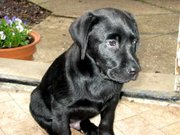 The coat of the black Labrador, like this puppy's, is solid black.
The coat of the black Labrador, like this puppy's, is solid black.
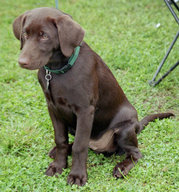 This young Labrador's coat is chocolate, which was not always recognized
as an acceptable coat color. Now chocolate is accepted along with black and
yellow.
This young Labrador's coat is chocolate, which was not always recognized
as an acceptable coat color. Now chocolate is accepted along with black and
yellow.
The Labrador is believed to have originated on the island of Newfoundland, now part of the province of Newfoundland and Labrador, Canada. It is thought to have descended from the St. John's Water Dog (no longer in existence), a crossbreed of native water Dogs and the Newfoundland to which the Labrador is closely related. The name Labrador was given to this Dog by the Earl of Malmesbury and other breeders in England in order to differentiate them from the Newfoundland Dog. The Labrador Retriever was originally called the lesser Newfoundland or the St. John's Dog. Other origins suggested for the name include the Spanish or Portuguese word for workers, "labradores", and the village of Castro Laboreiro in Portugal whose herding and guard Dogs bear a "striking resemblence" to Labradors [2].
Many fishermen originally used the Lab to assist in bringing nets to shore; the Dog would grab the floating corks on the ends of the nets and pull them to shore.
The first known written reference to the Labrador is in 1814 in "Instructions to Young Sportsmen". In 1823 sporting artist Edwin Landseer painted a black Dog with white markings titled "Cora. A Labrador Bitch," by which time it appears the breed was already firmly established, with several of the nobility either owning or breeding them by the end of that century. The first Yellow Lab on record, named Ben of Hyde, was born in 1899.
The modern Labrador Retriever is among the oldest of the modern "recognized" breeds; according to the American Kennel Club, pedigrees exist back to 1878. The Kennel Club recognized the Lab in 1903. The first registration of Labradors by the AKC was in 1917; many English Dogs were imported post World War I and these formed the foundation of the American variety.
Labradors are a well-balanced and remarkably versatile breed, adaptable to a wide range of functions as well as making very good pets. As a rule they are not excessively prone to territorialism, pining, insecurity, aggression, destructiveness, hypersensitivity, or other difficult traits which manifest in a variety of breeds, and as the name suggests, they are excellent retrievers. As an extension of this, they instinctively enjoy holding objects and even hands or arms in their mouths, which they can do with great gentleness. They are, however, prone to chew objects (though they can easily be trained out of this behavior). The Labrador Retriever's coat repels water to some extent, thus facilitating the extensive use of the Dog in waterfowl hunting.
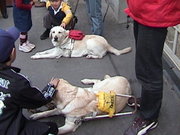 Labradors are often used as
guide Dogs
Labradors are often used as
guide Dogs
Labradors have a reputation as a very mellow breed and an excellent family Dog (including a good reputation with children of all ages), but some lines (particularly those that have continued to be bred specifically for their skills at working in the field rather than for their appearance) are particularly fast and athletic. Their fun-loving boistrousness and lack of fear can result in mischief, and may require training and firm handling at times to ensure it does not get out of hand. Anecdotally, between the different subtypes, black Labs may have a tendency to be slightly more dominant, and yellow to be slightly less so (more mellow). Most Labs enjoy retrieving a ball endlessly and other forms of activity (such as Dog agility or flyball), are considerably "food and fun" oriented, very trainable and open minded to new things, and thrive on human attention and interaction, which they find hard to get enough of.
The steady temperament of Labs and their ability to learn quickly make them an ideal breed for assistance Dogs.
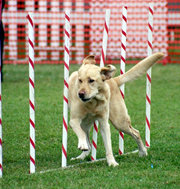 Some lines of Labs are fast and athletic, as demonstrated by this Lab doing the
weave poles in
Dog
agility.
Some lines of Labs are fast and athletic, as demonstrated by this Lab doing the
weave poles in
Dog
agility.
Labrador life expectancy is generally 12 to 13 years[3], and it is a healthy breed with relatively few major problems. Common Lab health issues are:
Miscellaneous
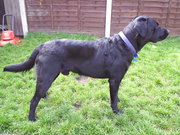 A black Labrador is structurally the same as a yellow Lab but the coat color
makes them look quite different.
A black Labrador is structurally the same as a yellow Lab but the coat color
makes them look quite different.
Puppy mills and Dog theft
Labrador variants
Famous Labs
References
3. ^ Fogle, Bruce, DVM (2000). The new Encyclopedia of the Dog. Doring Kindersley (DK). ISBN 0-7894-6130-7.
1. ^ B/b, E/e, and Beyond: A Detailed Examination of Coat Color Genetics in the Labrador Retriever, retrieved November 12, 2005.